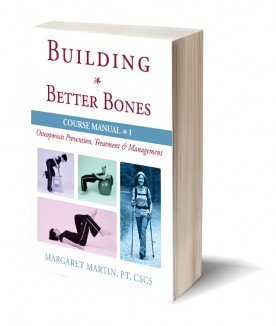Table of Contents
Welcome to Working with Osteoporosis for Physical Therapists. This is your first lesson and I am glad that you could join me.
Working with Osteoporosis Course Agenda
During the next four days I will cover the following topics:
- Bone Density and Bone Quality. New research and technological developments are challenging how researchers and clinicians evaluate a client’s bone health. I discuss the affect exercise plays in optimizing bone quality.
- Demystifying Exercise Prescription for Osteoporosis. I discuss the type of exercise programs that safely and effectively challenge our clients’ bone health.
- Nutrition and Pharmaceuticals. New research findings are calling into question the usage of certain supplements and pharmaceuticals.
- Your Practice. What should you be doing to prepare for the large number of clients with low bone density and osteoporosis?
I know that you find the course informative and look forward to your feedback.
Working with Osteoporosis • Lesson 1
I encourage you to check out the Building Better Bones online course for Physical Therapists, Physiotherapists, Kinesiologists, Athletic Trainers, Occupational Therapists and Physical Therapy Assistants.
Over 12,000 health professionals have completed this course.
“This course should be a mandatory part of all Physiotherapy training programs.” – Karen Ginsburg, Physiotherapist, Community Rehab Therapy, Hamilton, Ontario

Video Transcript
I’m Margaret Martin. I’m the creator of MelioGuide. I want to thank you for taking the time today to tune in and to find out more about osteoporosis and exercise.
I’m a Physical Therapist and Certified Strength and Conditioning Specialist.
Over the next five days I’m going to give you a snapshot of the things that you might be looking for on information about working with clients with low bone density or osteoporosis.
Some of you might have come to the site because you work with clients that are in the older age bracket.
You’re thinking, “Oh yeah, most of my clients have osteoporosis or a certain portion of my clients have osteoporosis” but I want to encourage those of you who might also be working with younger individuals, individuals even as young as early teens, because those are the ages that we can have a significant impact on someone’s skeletal health for the rest of their life.
Regardless of the age of your client, the information that you learn through MelioGuide can be adapted from teen years all the way through to my youngest client, who’s 94 years of age.
Over the next four days, we’re going to cover some important topics that clinicians should be aware of when working with individuals with osteoporosis.
We’re going to talk about the new guidelines in regards to calcium supplementation. We’ll look at pharmaceuticals.
We’ll then go on and look at demystifying exercise prescription in the role of osteoporosis.
And tomorrow we’re going to talk about some really interesting new findings as it comes to discussing bone density and bone quality, and how that affects someone’s fracture risk.
See you tomorrow.
Margaret Martin
Physical Therapist, Certified Strength & Conditioning Specialist
MelioGuide

Physical Therapy Continuing Education
To learn more about how to Physical Therapy Continuing Education, visit my page dedicated to Physical Therapy Continuing Education.

Comments